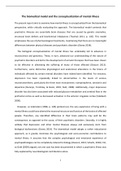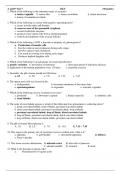The biomedical model and the conceptualization of mental illness
The present report aims to examine how mental illness is conceptualized from the biomedical
perspective, while critically evaluating the approach. The biomedical model contends that
psychiatric illnesses are essentially brain diseases that are caused by genetic anomalies,
structural brain defects and biochemical imbalances (Thachuk 2011, p. 145). This model
emphasizes the use of pharmacological treatments, maintaining that there are no meaningful
differences between physical diseases and psychiatric disorders (Davey 2014).
The biological conceptualization of mental illness has undeniably led to advances in
neuroscience and genomics. These, in turn, advanced our understanding of the nature of
psychiatric disorders and led to the development of somatic therapies that have been shown
to be effective in alleviating the suffering of many of those affected (Deacon 2013).
Furthermore, some distinctive physiological and anatomical alterations in the brains of
individuals affected by certain mental disorders have indeed been identified. For instance,
depression has been repeatedly linked to abnormalities in the levels of various
neurotransmitters; particularly the three main monoamines: norepinephrine, serotonin and
dopamine (Naranjo, Tremblay, & Busto, 2001; Nutt, 2008). Additionally, major depressive
disorder has also been associated with reduced glucose metabolism and cerebral flow in the
prefrontal cortex as well as decreased activation in the anterior cingulate cortex (Videbech
2000).
However, as Valenstein (1998, p. 128) pointed out, the very experience of living with a
mental illness could have altered the neuronal structure and function of the brains of affected
people. Therefore, any identified difference in their brain patterns may well be the
consequence, as opposed to the cause, of their psychiatric disorders. Secondly, it is highly
unlikely that depression and other mental illnesses always and exclusively stem from
biological dysfunctions (Davey 2014). The biomedical model adopts a rather reductionist
approach, as it greatly minimizes the psychological and socio-economic contributions to
mental illness. It assumes that the complex psychological and emotional experience of
psychopathologies can be completely reduced to biology (Deacon, 2013; Schultz, 2018). Yet,
as Gold (2009) argued, not one case has been documented in which a psychiatric illness was
fully explained by neurobiological contributions alone.
1
, Biochemical and biogenetic causal explanations were once hoped to significantly reduce
the stigma associated with psychiatric illnesses by depicting affected individuals as blameless
sufferers of legitimate medical conditions (Lebowitz 2014). However, the public’s increasing
acceptance of biological explanations for mental disorders did not translate into improved
overall attitudes towards those living with these illnesses (Pescosolido et al. 2010). The initial
assumption rested on the attribution theory, which postulates that ascribing a stigmatized
characteristic to a cause out with a person’s control- in this case his/her biology- would
alleviate personal blame and consequently social rejection (Corrigan 2000). However, mental
illness stigma is multifaceted, and its various aspects tend to respond to biological causal
explanations differently (Haslam & Kvaale 2015). Although biological explanations have been
repeatedly linked to decreased personal blame ascribed to symptomatic individuals, as
predicted by the attribution theory, they have also been associated with prognostic
pessimism, a desire for greater social distance as well as an increased tendency to regard the
affected people as dangerous (Kvaale, Gottdiener, & Haslam, 2013; Kvaale, Haslam, &
Gottdiener, 2013).
Some authors (Haslam, 2000; Phelan, 2005) argued that biological explanations may evoke
essentialist thinking, in which the sufferers are viewed as inherently different, due to having
an ‘immutable pathological essence’. Such thinking is likely to lead to prognostic pessimism
by reinforcing perceptions of mental illnesses as chronic and resistant to treatment (Haslam
2011). Additionally, by suggesting that people with mental illnesses cannot be held
responsible for their psychiatric conditions and symptomatic behaviours, the biomedical
model generates generalized fear that such individuals are inherently unpredictable and
consequently more dangerous than the general population (Thachuk, 2011, p. 153).
Numerous research studies (Kemp, Lickel, & Deacon, 2014; Lebowitz, Ahn, & Nolen-
Hoeksema, 2013; Read, Cartwright, Gibson, Sheils & Haslam, 2014) reported that individuals
experiencing depression, who endorsed biological causal beliefs for their symptoms were also
more pessimistic about their recovery and viewed psychological therapies as less effective
than pharmacotherapy. Such findings have important clinical implications. Firstly, outcome
expectancies have been shown to affect actual treatment outcomes and recovery significantly
(Alladin 2013). Secondly, while antidepressant medications can treat depressive symptoms
successfully and prevent their return as long as the treatment is continued, these drugs do
2
The present report aims to examine how mental illness is conceptualized from the biomedical
perspective, while critically evaluating the approach. The biomedical model contends that
psychiatric illnesses are essentially brain diseases that are caused by genetic anomalies,
structural brain defects and biochemical imbalances (Thachuk 2011, p. 145). This model
emphasizes the use of pharmacological treatments, maintaining that there are no meaningful
differences between physical diseases and psychiatric disorders (Davey 2014).
The biological conceptualization of mental illness has undeniably led to advances in
neuroscience and genomics. These, in turn, advanced our understanding of the nature of
psychiatric disorders and led to the development of somatic therapies that have been shown
to be effective in alleviating the suffering of many of those affected (Deacon 2013).
Furthermore, some distinctive physiological and anatomical alterations in the brains of
individuals affected by certain mental disorders have indeed been identified. For instance,
depression has been repeatedly linked to abnormalities in the levels of various
neurotransmitters; particularly the three main monoamines: norepinephrine, serotonin and
dopamine (Naranjo, Tremblay, & Busto, 2001; Nutt, 2008). Additionally, major depressive
disorder has also been associated with reduced glucose metabolism and cerebral flow in the
prefrontal cortex as well as decreased activation in the anterior cingulate cortex (Videbech
2000).
However, as Valenstein (1998, p. 128) pointed out, the very experience of living with a
mental illness could have altered the neuronal structure and function of the brains of affected
people. Therefore, any identified difference in their brain patterns may well be the
consequence, as opposed to the cause, of their psychiatric disorders. Secondly, it is highly
unlikely that depression and other mental illnesses always and exclusively stem from
biological dysfunctions (Davey 2014). The biomedical model adopts a rather reductionist
approach, as it greatly minimizes the psychological and socio-economic contributions to
mental illness. It assumes that the complex psychological and emotional experience of
psychopathologies can be completely reduced to biology (Deacon, 2013; Schultz, 2018). Yet,
as Gold (2009) argued, not one case has been documented in which a psychiatric illness was
fully explained by neurobiological contributions alone.
1
, Biochemical and biogenetic causal explanations were once hoped to significantly reduce
the stigma associated with psychiatric illnesses by depicting affected individuals as blameless
sufferers of legitimate medical conditions (Lebowitz 2014). However, the public’s increasing
acceptance of biological explanations for mental disorders did not translate into improved
overall attitudes towards those living with these illnesses (Pescosolido et al. 2010). The initial
assumption rested on the attribution theory, which postulates that ascribing a stigmatized
characteristic to a cause out with a person’s control- in this case his/her biology- would
alleviate personal blame and consequently social rejection (Corrigan 2000). However, mental
illness stigma is multifaceted, and its various aspects tend to respond to biological causal
explanations differently (Haslam & Kvaale 2015). Although biological explanations have been
repeatedly linked to decreased personal blame ascribed to symptomatic individuals, as
predicted by the attribution theory, they have also been associated with prognostic
pessimism, a desire for greater social distance as well as an increased tendency to regard the
affected people as dangerous (Kvaale, Gottdiener, & Haslam, 2013; Kvaale, Haslam, &
Gottdiener, 2013).
Some authors (Haslam, 2000; Phelan, 2005) argued that biological explanations may evoke
essentialist thinking, in which the sufferers are viewed as inherently different, due to having
an ‘immutable pathological essence’. Such thinking is likely to lead to prognostic pessimism
by reinforcing perceptions of mental illnesses as chronic and resistant to treatment (Haslam
2011). Additionally, by suggesting that people with mental illnesses cannot be held
responsible for their psychiatric conditions and symptomatic behaviours, the biomedical
model generates generalized fear that such individuals are inherently unpredictable and
consequently more dangerous than the general population (Thachuk, 2011, p. 153).
Numerous research studies (Kemp, Lickel, & Deacon, 2014; Lebowitz, Ahn, & Nolen-
Hoeksema, 2013; Read, Cartwright, Gibson, Sheils & Haslam, 2014) reported that individuals
experiencing depression, who endorsed biological causal beliefs for their symptoms were also
more pessimistic about their recovery and viewed psychological therapies as less effective
than pharmacotherapy. Such findings have important clinical implications. Firstly, outcome
expectancies have been shown to affect actual treatment outcomes and recovery significantly
(Alladin 2013). Secondly, while antidepressant medications can treat depressive symptoms
successfully and prevent their return as long as the treatment is continued, these drugs do
2




